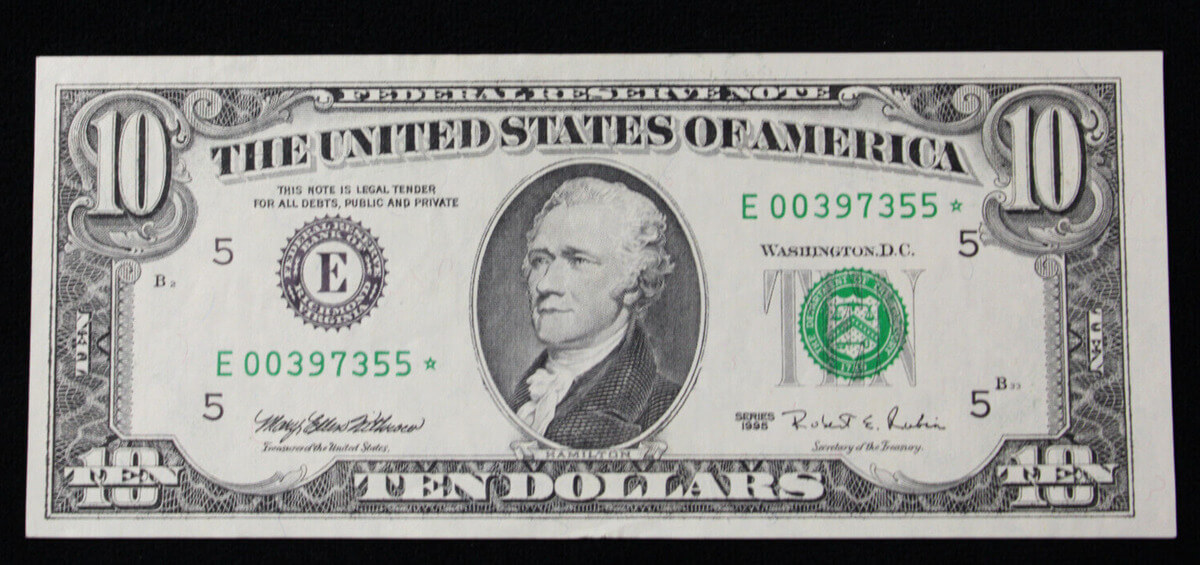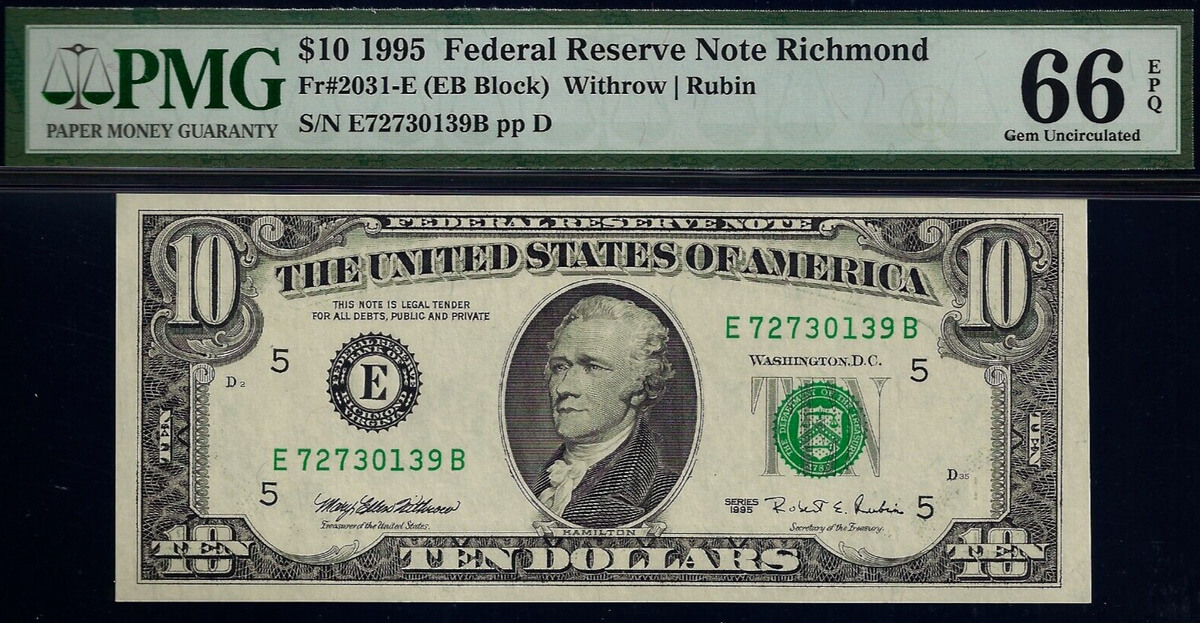The 1995 10 Dollar Bill is a unique piece of currency that has intrigued collectors and enthusiasts for years. While most of these bills may not hold much value beyond their face value, there are exceptions. Whether you’re a seasoned collector or a casual observer, understanding the worth, history, and rarity of the 1995 ten dollar bill can be fascinating.
This article delves into the value of the 1995 $10 bill, including the factors that contribute to its pricing, the distinction between standard and star notes, and how to identify genuine bills.

If you own a 1995 10 Dollar Bill, keep reading to discover its potential value in the world of paper money.
Introduction To The 1995 10 Dollar Bill
The 1995 $10 bill, part of the Federal Reserve Note series, was printed in the United States at two distinct locations: Washington D.C. and Fort Worth, Texas. Most 1995 ten dollar bills are not considered valuable beyond their face value.
However, the condition of the bill, as well as certain rare variations such as star notes, can significantly increase their worth.
In the world of currency collecting, the value of a 1995 ten dollar bill largely depends on its condition and any special characteristics it might possess. While it’s rare for a 1995 $10 bill to be worth more than the printed face value, a star note or an uncirculated bill can fetch a higher price from collectors.
The Basic Specifications Of The 1995 $10 Bill
Before diving into the value and other details, it is important to know the basic specifications of the 1995 $10 bill. The denomination of the bill is $10 USD, and it falls under the category of a Federal Reserve Note.
The 1995 series was issued with two main signature combinations, Withrow and Rubin, which help in identifying the note’s authenticity.
The bill was printed at two distinct locations: Washington D.C. and Fort Worth, Texas. To determine the origin of the note, collectors can look for a small “FW” symbol on bills printed in Fort Worth, Texas, located next to the green seal on the front of the note.
This tiny detail can play an important role in identifying the bill and influencing its potential value.
The General Worth Of A 1995 Ten Dollar Bill
For most individuals who own a 1995 $10 bill, it is important to understand that the majority of these bills are not worth much more than their face value of $10. In circulated condition, these bills are typically not considered rare or particularly valuable.
The general consensus in the currency market is that bills that have been used and circulated extensively will not appreciate beyond the original printed value.
However, the value of the 1995 $10 bill can rise depending on its condition. A bill that is in “extremely fine” condition can be worth around $12.50. If a bill is uncirculated and receives a high grade, such as MS 63, it can be valued at approximately $25.
The difference in value can be attributed to the bill’s crispness and overall condition. Notes that remain uncirculated, meaning they show no signs of being in circulation, command a premium.
An uncirculated 1995 $10 bill is in pristine condition, maintaining its original crispness, colors, and centering.
Star Notes: A Rare and Valuable Variation
One of the most important factors that can increase the worth of a 1995 $10 bill is the presence of a star note. Star notes are replacement bills issued by the U.S. Federal Reserve when a regular note is found to be damaged or defective during production.
These notes are often more rare than their regular counterparts, which significantly enhances their value.
Star notes can be identified by the presence of a star symbol at the end of the serial number on the bill. If you find a 1995 $10 bill with this distinguishing feature, it’s likely to be worth more than a standard note, even in circulated condition.
The value of a star note can vary depending on its condition and the series from which it originated.
Most 1995 series $10 star notes are valued at around $15-$27.50 in extremely fine condition. However, uncirculated star notes with a grade of MS 63 can command a price range of $40-$62.50, making them much more valuable than regular notes.
One key factor in the value of star notes is the location where they were printed. Star notes from the Federal Reserve Bank of Atlanta, printed in Washington D.C., are often more valuable compared to those printed in other locations.
The rarity of these notes plays a crucial role in determining their final worth on the collector’s market.
Grading System for 1995 Ten Dollar Bill
When it comes to determining the value of a 1995 $10 bill, understanding the grading system is essential. The condition of the bill is one of the most important factors influencing its value, and there are specific terms used to describe the bill’s condition.
- Extremely Fine (EF): A bill in this condition will show only slight signs of wear from circulation. It will still maintain much of its original crispness and will have no stains, tears, or discolorations. A bill graded as Extremely Fine will have only minimal creases or folds, if any.
- Choice Uncirculated (MS 63): A bill in this condition has never been in circulation. It retains its original crispness and shows no signs of wear. Additionally, the note is well-centered, with no misprints or defects that would affect its overall appearance. Uncirculated bills are generally valued higher than those that have been in circulation.
For collectors, the grading system is essential in determining how much a 1995 $10 bill is worth. A bill that has been well-preserved in perfect condition will be far more valuable than one that shows significant signs of wear and tear.
Thus, the value of a 1995 ten dollar bill increases with its grade.
The Importance Of Paper and Money Features
As with any currency, the material and features of the 1995 $10 bill contribute to its authenticity and value. The bill is printed on a unique blend of cotton and linen, which gives it a distinct feel and texture.
This high-quality paper is designed to withstand wear and tear, making the bill durable and long-lasting.
To verify the authenticity of a 1995 $10 bill, collectors can perform a simple test. Hold the note up to the light, and you should be able to see a security thread running vertically on the left side of the Federal Reserve Bank seal.
The thread is imprinted with the word “TEN” and the letters “USA” in an alternating pattern.
When illuminated with ultraviolet light, the thread will glow orange, which is another way to confirm the bill’s legitimacy.
Conclusion: The Final Value Of The 1995 10 Dollar Bill
The most 1995 10 dollar bill are worth their face value of $10 unless they are in exceptional condition or are star notes. However, the value of these bills can significantly increase depending on factors such as their condition, grading, and rarity.
Star notes, particularly those from the Federal Reserve Bank of Atlanta, are much more valuable and can be worth as much as $62.50 or more in uncirculated condition.
The 1995 ten dollar bill is a fascinating piece of history, and for collectors, understanding its worth can make all the difference when it comes to determining its value in the world of paper money.
Knowing what to look for can help you understand its true worth. If you happen to own a 1995 10 Dollar Bill, consider getting it appraised to see if it holds greater value than you might expect.

